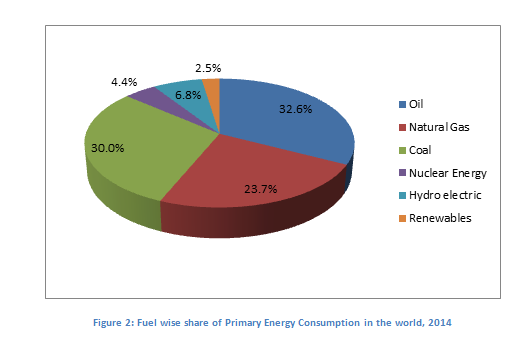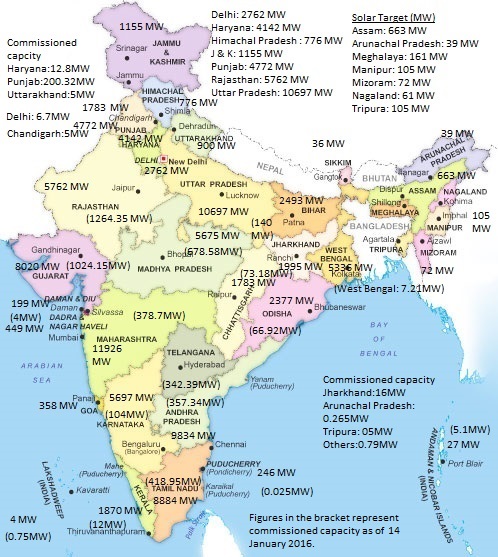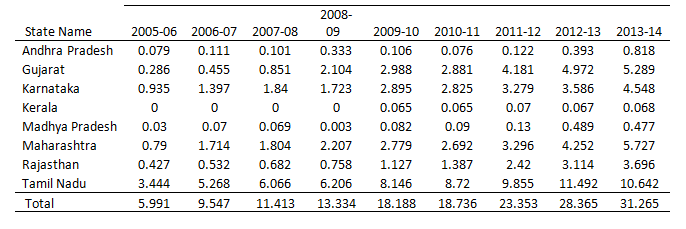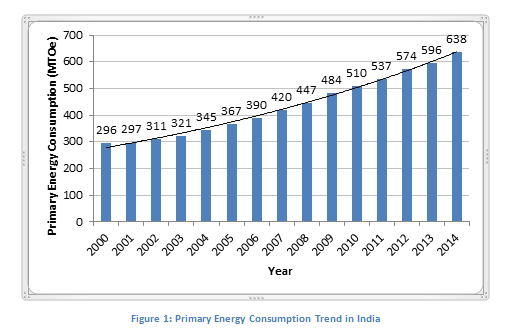I. Background
India’s green energy revolution is gradually picking up momentum owing to increased concerns for climate change and its impact on environment, human being, and above all a bigger concern for protecting mother earth for the future generation. India’s National Action Plan on Climate Change (NAPCC) 2008[i] proposed setting up 8 missions including the National Solar Mission to drive sustainable and green developments in the country. In many ways the NAPCC laid the foundation for low carbon economy. However, in a country like India with 1.3 billion people, achieving high economic growth with low carbon remains a challenge.
Over a period of time it has been realized that the low carbon economy is not a choice to be exercised rather the ultimate path to follow with absolute internal drive and passion. The resultant outcome is the Intended National Commitment (INDC)[ii], 2015 declaration which includes reduction in the emissions intensity of its GDP by 33 to 35 percent by 2030 from 2005 level and creation of an additional carbon sink of 2.5 to 3 billion tonnes of carbon dioxides (CO2) equivalent through additional forest and tree cover by 2030. This noble intention would be difficult to realize without cohesive, collaborative, and comprehensive efforts among the stakeholders like Government & its agencies, policy makers, multilateral agencies, investors, consumers, and other concerned for the mother earth.
India’s energy needs are constantly increasing (fig.1) and in 2014 with 7.2 percent growth it was one of highest growing economies in the world. In 2017, with projected economic growth of 7.5 percent, India is expected to be ahead of China (6.5 percent)[iii]. The Economist Intelligence Unit projects India to be the 3rd largest economy with GDP of $63.84 trillion by 2050[iv]. This means, India will require more energy to sustains its economic growth and attain prosperity. Still millions of Indians suffer from energy poverty and many industries face challenges of meeting their energy needs from reliable sources at affordable price. However, the energy story is being rewritten with a significant focus on increasing affordable clean energy supply and eradicating energy poverty in the country-possibly such a dream would come true within a decade. This may sound too ambitious but not beyond reach of India.
India has been making all necessary efforts to reduce dependence on less environment friendly energy sources and promote green energy in a big way.
Figure 1: Primary Energy Consumption Trend in India
This article presents brief overview of ill effects of coal, fossil fuel excluding natural gas, nuclear and discusses merits of green energy. The author discusses past, present, and future of green energy in India and highlights key policy initiatives to ensure growth of green and sustainable economy.
II. Ill effects of coal and fossil fuel
Most of the fossil fuels are not very environment friendly; especially coal is highly polluting but it has been the most preferred fuel across the globe for a long time. Even other liquid fossil fuels are not far behind coal in terms of preference and environmental pollution. Harmful emissions like nitrogen oxides, sulfur oxides, carbon monoxide and carbon dioxide from burning fossil fuels cause serious environmental and health hazards. Carbon monoxide and dioxide are primarily responsible for global warming resulting in weather, droughts, floods, drastic temperature changes, heat waves, and more severe wildfires[v]. Some of the negative health effects of coal include reduction in life expectancy, congestive heart failure[vi], chronic bronchitis, asthma attack, and black lung[vii].
Often these externalities of fossil fuel are easily ignored for the shake of development or reduction in energy poverty. Despite all kinds of threats from fossil fuel most of the countries have been subsidizing polluting energy for a long time; in a sense the future generation will bear the casualties for the misdeeds of past and current generation. Internationally, governments provide at least $775 billion to perhaps $1 trillion annually in subsidies[viii], which serves as an incentive to deteriorate the environment. India provided INR 57,769 crore[ix] ($8.72 billion) petroleum subsidy in 2014-15. Due to decontrol of petrol (gasoline) and diesel prices, the subsidy component is coming down.
Owing to proven ill effects of coal and other fossil fuels, the developed and developing nations are gradually moving toward green economy. Recent evidences suggest that the fossil fuels have been getting killed by falling prices and, more recently, declining investment[x]. Renewable energy is fast emerging as a commercially viable option across the globe. In countries like China, the USA, and Germany renewable energy has been making remarkable progress and positively impacting the economy.
Similarly, India is beginning to take a long stride with a massive ambition of driving green growth by 2022 and beyond. The transport sector is one of the largest users of the fossil fuel and one of the biggest offenders of environmental pollution. To reduce ill effects of fossil fuel, the Government is planning for a smooth and complete transition of mobility sector from fossil fuel to hybrid or electric vehicles by 2030.
III. Dangers of nuclear
A thorough examination of the full life-cycle of nuclear power generation reveals nuclear power to be a dirty, dangerous and expensive form of energy that poses serious risks to human health[xi]. Despite proponents claiming nuclear power is safe, the history of nuclear energy is marked by a number of disasters and near disasters. Some of the notable disasters are Chernobyl 1986 (Ukraine), Fukushima 2011 (Japan), Kyshtym 1957 (Russia), Windscale Fire 1957 (Great Britain), Pennsylvania 1979 (USA), Goais 1987 (Brazil), Idaho 1961 (USA), Saint Laurent 1969 (France), Bueno Aires 1983 (Argentina), and Tokaimura 1999 (Japan). Such unfortunate incidents cause serious damages including loss of life, defects, thyroid cancer leading to loss of life[xii], radioactive spread, soil & water contamination, displacement of people, and destruction of environment.
Fortunately there are no major nuclear accidents happened in India. However, there are several small incidents[xiii] reported in India, raising serious concern over safe use of nuclear power. The latest incident reported at Kakrapar Unit-1, Gujarat reactor where leakage of heavy water detected on 11 March 2016, thereafter the plant was shut down. A leak of this nature in an actively running atomic station has never occurred in India, so there is a need for systemic review of functioning of nuclear power plants to ensure zero level of accidents. Currently India has 21 nuclear power plants with installed capacity of 5780 MW[xiv] and the capacity augmentation programs aim to achieve 63 GW[xv] by 2032. Considering nature of risks involved in the nuclear power, generation of electricity from nuclear is quite risky, so utmost care should be taken to minimize risks involved with nuclear power. Providing electricity to people and reducing energy poverty in the country is very important, but nothing is more important than saving precious life.
In light of the above, other renewable and green energy sources found to be better alternatives to achieve higher energy penetration and reduce energy poverty without causing any harm to the human being and the environment.
IV. Merits of green energy
Green energy offers many benefits including lower or zero carbon emission, environment protection, improved public health, reduced pollution related diseases, and lower/zero fuel cost compared to black energy sources like coal and oil. Increasing the supply of renewable energy would enhance replacement of carbon-intensive energy sources and significantly reduce global warming emissions. This would be certainly helpful to achieve Intended Nationally Determined Contribution (INDC) target committed by India.
Compared with fossil fuel technologies, which are typically mechanized and capital intensive, the renewable energy industry is relatively labor-intensive[xvi], which results in more job creation across the renewable energy value chain. Especially the renewable energy could revitalize the small scale industry developments across the nation. Skilled manpower would be needed for solar installation, manufacturing, and sales—which would create demand for skill development and institutions providing training and skill upgradation programs.
Massive renewable energy development programs in India need financial investments close to $200 billion, which could act as a catalyst to develop new financing models and channels of financing.
Further, growth and development of renewable energy industry is bound to fuel economic prosperity by boosting both manufacturing and services industry. Increased use of renewable may lead to reduced dependency on imported fossil fuel and help India move toward achieving the much-needed self-sufficiency and energy independence.
V. Green energy in India: historical perspective
Green energy includes primarily renewables like solar, small hydro, wind, biomass, and natural gas. Some of the sources have been there since the inception of the earth and others developed over a period of time. But mass scale use of green energy in the country is relatively young compared to other forms of energy. The following section provides source wise brief historical developments of green energy in the country.
Solar program dates back to 1984 when a subsidy-based solar thermal programme[xvii] was launched and continued up to 1993. Till 2010, solar programs were very static and limited to few proactive states. The Jawaharlal Nehru National Solar Mission[xviii] was launched on 11 January, 2010 to push growth of solar energy in the country. The Mission set an ambitious target of deploying 20,000 MW of grid connected solar power and achieve grid tariff parity by 2022.
Research and development of biogas technologies started in 1920s and All India Coordinated Biogas Programme was launched in 1975 for large-scale dissemination of biogas plants. Subsequently various biogas programs were launched to meet the energy needs of the rural India through green and renewable fuels. In addition to improving energy supply, biogas offers following other benefits:
i. It improves sanitation in villages and semi -urban areas by linking sanitary toilets with biogas plants.
ii. Digested slurry from biogas plants is used as enriched bio-manure to supplement the use of chemical fertilizers.
iii. Biogas plants help in reducing the causes of climate change.
Wind power programs were initiated toward the end of the sixth plan in 1983–1984, and by 2015, with 5.5 percent of global cumulative installed wind capacity, India became the fourth largest wind market in the world[xix]. Wind energy programs have been the most successful among the renewable energy programs in the country. However, compared to China, India’s progress has been very slow.
VI. Natural Gas: a bridge fuel
Globally natural gas is considered as a greener fuel, in many countries including India, it is preferred as a bridge to manage the transition of carbon intensive economy to green economy. Though natural gas is a fossil fuel but it emits less greenhouse gases compared to other hydrocarbons like coal and oil.
Natural gas resource rich as well as deficient countries use natural gas for meeting their primary energy needs; in 2014, out of 12928.4 million tonnes of oil equivalent (MTOe) natural gas contributed 3065.5 MTOe[xx] which is 23.7 percent (fig.2) of total primary energy consumption in the world. With 610.7 MTOe, Asia Pacific contributed 19.9 percent of the total natural gas consumption and India’s share was just 1.5 percent. It is to be noted that share of natural gas in the primary energy consumption stood at 7.1 percent which is much lower that global average of 23.7 percent. So, it is very fair to argue that the share of natural gas would go up in the future.

Historically the factors which influenced lower consumption of natural in India are many but some of the notable factors are: limited domestic natural gas reserves, lower production, lack of gas importing infrastructure, and insufficient nationwide domestic pipeline infrastructure.
Over the year the Government has been trying to address limiting factors and creating conducive environment for developing a robust natural gas market, thereby increasing share of natural gas production, import, transport, and consumption in the country.
To promote higher production of natural gas the Government move away from allocation of production blocks on nomination to bidding under New Exploration and Licensing Policy implemented in 1999, more recently in 2016, Government introduced Hydrocarbon Exploration and Licensing Policy (HELP)[xxi]. The HELP introduces revenue sharing model which replaces the cost sharing model under NELP, which is expected to reduce conflict between the Government and contractors. Further, under the HELP, provision for higher prices for natural gas produced from off-shore blocks intend to attract more investment and increase gas production. However, the anticipated results to be seen over a period of time.
To bring vibrancy in the downstream business, the Government brought regulatory reforms in the downstream business by enacting Petroleum & Natural Gas Regulatory Board (PNGRB) Act, 2006 and establishing PNGRB in 2007. Since then, the regulator has been taking necessary measures to promote fair competition in pipeline and city gas distribution business. So far about 67 geographically areas are authorized by the PNGRB for laying, building, and expanding city gas distribution network. Currently about 3 million domestic households receive piped natural gas (PNG) and the Government targets to achieve 10 million domestic PNG connections by 2019, which is more than threefold increase within a short span of time. This is an indication that the Government is strongly pushing green drive.
VII. Renewable energy: current and future
Solar
As of 14 January 2016, the cumulative installed capacity of solar power stood at 5,130 MW and 1633 MW was added till March 2016, taking the total capacity to 6763MW. Rajasthan, with over 1264 MW commissioned capacity leads the table followed by Gujarat (1024MW), Madhya Pradesh (678.6MW), Maharashtra (378.7MW), and Andhra Pradesh (357.3MW). The Government targets to achieve 100GW by 2022, 20 fold increase from the current level and fig.3 presents state wise break up of solar targets in the country.

Source: Partially adapted from Kar and Sharma (2016). Solar energy market developments in India. Renewable & Sustainable Energy Reviews.
To achieve a very stiff target of 100GW by 2022, the Government, regulators, developers, and investors need to work together in a coherent manner. The state machinery seems to be geared up for the quantum jump. However, some of the areas including finding investors ready to invest in relatively risky projects with anticipated long-term return, ensuring off-take of solar power by the state distribution companies, developing smart grids to address intermittency, storage of solar power, and developing domestic component manufacturing industry demand greater level of attention and action.
In the recent times, the Government seems to be quite happy about downward dive of solar tariff. Let alone the Government even the producers enjoying the aggressive bidding to win large scale projects and lower the existing tariff. Needless to mention that the fall in price is always appreciated by the consumers.
The solar industry just passed the introduction stage and beginning to enter the growth stage which is evidence from large participation of developers and the too aggressive bidding for winning. Solar tariff has been showing a declining trend, in March 2016, Finland-based energy firm Fortum Finnsurya Energy won a tariff bid at INR4.34/kWh (7 cents USD[xxii]) for 70 MW project in Bhadla Solar Park in Rajasthan. Other developers like Rising Sun Energy Pvt Ltd, Solairedirect, and Yarrow Infrastructure were awarded projects with a tariff of INR4.35/kWh, INR4.35/kWh[xxiii], and INR4.36/kWh respectively. Such low tariff could be ascribed to irradiation, infrastructure costs at that location, credibility of the off-taker (NTPC), and the economies of scale in putting up a large project in one location[xxiv]. Earlier in November 2015, SunEdison won solar projects in Andhra Pradesh, offering to sell power at INR4.63 a kWh, a new low then.
However, over the declining trend of solar tariffs many people are raising concerns. “It looks like tariffs are being influenced by something beyond the ground realities,” Bikesh Ogra, President, Sterling & Wilson, India’s largest solar EPC company[xxv]. SunEdison filling bankruptcy in the United States and looking for equity partners for projects in India—offers enough indications that the producers in India may face problem in the future. At this stage the developers should understand it is not all about just winning but about winning and sustaining the market over a period of time. It is advisable that the producers should carefully manage their assets and projects for sustainable cash flows and profitability. Far too aggressive bidding without economic sense may create uneasy situations for companies, investors, government, regulators, and finally the consumers.
Future solar growth will depend on proactive policies developed by states like Uttar Pradesh, Karnataka, and West Bengal having higher potentials and targets. In addition, under the ‘Make in India’ initiative solar component manufacturing industry is expected to get boost to support higher solar penetration in India.
Solar energy has been used for water heating, by the end of March 2016, 8.9 million square meter of collection areas installed for Solar Water Heating purpose. The Ministry of New & Renewable Energy provides 30 percent capital subsidy to farmers for installation of solar pumps for irrigation purpose through state nodal agencies. Through this scheme the Government plans to install 100 thousand solar pumps and by far financial support of INR3500 million released for the installation of solar pumps[xxvi].
Wind
Wind energy development in India has been relatively slow compared to other countries like China, the United States, Germany, and Spain.[xxvii]By the end of March 2016, cumulative wind installation reached 26743.6MW, which is about 62.6 percent of total grid connected renewable power in the country. India added 3300 MW wind capacity during April 2014-March 2015, which is 37.5 percent higher than the target of 2400MW. The government targets to achieve a cumulative capacity of 60GW by 2022, about 4.75 GW of capacity addition every year till 2022 is quite achievable.
Actual wind power generations exceeded 31 billion units (BU) in 2013-14 compared to about 6 BU in 2005-06 (Table1) – which is 5.2 higher than 2005-06 level. Since 2009 wind power generations has been well supported by a Generation Based Incentive (GBI) Scheme for wind power projects not availing the Accelerated Depreciation (AD) benefit. Wind projects eligible for GBI could get incentive at the rate of INR 0.50 per unit of power fed to the grid subject to the ceiling of INR 10 million per MW[xxviii].
Table 1: Wind power generation (Billion Unit) in leading states in India[xxix] (As on 31.12.2014)

So far the entire wind capacity has been developed on-shore, and off-shore wind yet to be developed in India. The Government is actively considering development of off-shore wind farms to harness off-shore wind potential up to 350GW[xxx] in the country. Off-shore wind faces the challenges of managing cost and keeping the tariff down. Therefore, National Off-shore Wind Energy Policy,2015 intends to: provide fiscal incentives, allow Foreign Direct Investment (FDI) participation, promote Public Private Partnership, and encourage international collaborations[xxxi]. A dedicated off-shore wind policy would certainly address the bottlenecks and facilitate production of off-shore wind in the country.
Further, like The National Solar Mission, National Wind Mission is under consideration, implementation of which would boost faster growth of wind market in India.
Small hydro
As of 31 March 2016, cumulative installed capacity of grid interactive small hydro (<25MW) power plants stood at 4274MW, which is about 10 percent of total renewable capacity. The estimated potential for power generation in the country from small hydro plants upto 25MW is about 20,000 MW[xxxii]. Most of the potential is in Himalayan States as river-based projects and in other States on irrigation canals. The small hydro power is economically viable with competitive tariff.
Biogas
In India, currently about 4.86 million family Biogas plants are operational which primarily serve energy needs for cooking in the rural households. These households in the countryside have limited or no access to liquefied petroleum gas or piped natural gas connections. Biogas plants offer them access to green energy free of cost which is available as per their convenience.
BioPower
By the end of March 2016, cumulative installed capacity of grid interactive BioPower (Biomass & Gasification and Bagasse Cogeneration) stood at 4831 MW, which is about 11% of total renewable capacity of 42726.8MW.
The Government is already running a scheme namely ‘The Unnat Chulha Abhiyan’ with intent of developing and promoting deployment of efficient and cost effective improved biomass cook-stoves in the country. Already 350 thousand biomass based cooking stoves have been sanctioned, which are expected providing clean cooking option to families, especially in the rural areas.
Hydrogen
Hydrogen is expected to contribute in a big way to reduce dependence on fossil fuel. Most of the leading academic institutions, research organizations, and some of the R&D centres of corporates are working on hydrogen production, storage, and applications in India. Fig.4 presents Hydrogen-Diesel dual fuel vehicle developed by Mahindra & Mahindra in India. In the future hydrogen driven vehicles would be plying on Indian roads.

Figure 4: Hydrogen-Diesel dual fuel vehicle developed by Mahindra & Mahindra in India
Source: http://mnre.gov.in/related-links/new-technologies/hydrogen-energy/
Renewable energy has its limitations and some of the biggest limitations are intermittency and storage. However, in the future such issues would be resolved by new technologies like power to gas, which would enable large scale storage of renewable power. In the long run the renewables would be helpful to reduce fiscal deficit and improve balance of trade of the country, because of lower dependence on imported energy.
- Conclusion
There has been a strategic shift from subsidy driven black energy to carbon taxation regime and financing of green energy, especially renewables. The Government is gradually moving away from ‘Planning’ mode to ‘Mission’ mode to bring much needed green energy revolution in the country. The National Solar Mission is already in place and The National Wind Mission is being given a serious thought to exploit renewable potential in the country.
Notable progress has been observed in the solar sector with large scale installations taking place through transparent auction process, thereby bringing down the tariff much closer to the grid parity. Once the most expensive green energy, Solar is now becoming affordable, acceptable, and accessible to consumer. Large participation of domestic and international developers in the tendering process indicates attractiveness of the sector, but commercial viability and sustainability of the solar industry at current price point is a big concern.
On the wind front the Government is pushing off-shore wind installation and generation through setting up ‘Wind Economic Zone’ and single window clearance system to make the development process smoother and faster. Key issues the renewable industry faces today are: securing financing at competitive interest rate, selling renewable energy, building evacuation infrastructure, and lack of well-developed renewable policy or implementation of the same. Further, growth of renewables would pose challenges like storage and transmission imbalance in the near future. It seems that the challenges are far more than the opportunities for the time being. However, the Government is constantly trying to address concerns of the developers and the investors. All the stakeholders need to understand the limitations and work within the boundaries to succeed.
The heartening fact is that to further progress of renewable generation, distribution, and consumption Renewable Energy Act being proposed. The proposed Act would provide much needed thrust to improve renewable production, distribution, mandatory purchase and increased consumption of renewable energy in the country.
Considering the past and present developments related to green energy, India’s future looks more than promising. I am quite sure over a decade India would emerge as one of the best green economies in the world.
Acknowledgement
I would like to extend my gratitude to Mr. Ghulam M. Suhrawardi for inviting me and giving an opportunity to contribute to South Asia Journal. Suggestions offered by Mr. Suhrawardi to develop the framework for this article is highly appreciated.
[i] http://www.moef.nic.in/sites/default/files/Pg01-52_2.pdf accessed on 5 April 2016
[ii] http://www4.unfccc.int/submissions/INDC/Published%20Documents/India/1/INDIA%20INDC%20TO%20UNFCCC.pdf accessed on 5 April 2016.
[iii] World Economic Situation and Prospects 2016. United Nations. <http://www.un.org/en/development/desa/policy/wesp/wesp_current/2016wesp_full_en.pdf> accessed on 25 April 2016
[iv] http://pages.eiu.com/rs/783-XMC-194/images/Long-termMacroeconomicForecasts_KeyTrends.pdf accessed on 25 April 2016
[v] http://www.ehow.com/list_6117346_negative-effects-fossil-fuel.html accessed on 18 April 2016
[vi] Coal’s assault on human health <http://www.psr.org/assets/pdfs/psr-coal-fullreport.pdf> accessed on 18 April 2016.
[vii] http://www.sourcewatch.org/index.php/Health_effects_of_coal accessed on 18 April 2016.
[viii] http://priceofoil.org/fossil-fuel-subsidies/ accessed on 18 April 2016
[ix] State of the Economy: An Overview, Economic Survey 2015-16, Government of India. P.41.
[x] http://www.bloomberg.com/news/articles/2016-04-06/wind-and-solar-are-crushing-fossil-fuels accessed on 18 April 2016.
[xi] http://www.psr.org/resources/nuclear-power-factsheet.html?referrer=https://www.google.co.in/ accessed on April 18, 2016
[xii] http://www.history.com/news/historys-worst-nuclear-disasters accessed on 18 April 18, 2016.
[xiii] http://www.greenpeace.org/india/en/What-We-Do/Nuclear-Unsafe/Safety/Nuclear-accidents/Nuclear-accidents-in-India/Accidents-at-nuclear-power-plants/ accessed on 18 April 2016.
[xiv] http://www.npcil.nic.in/main/allprojectoperationdisplay.aspx accessed on 18 April 2016.
[xv] http://www.world-nuclear.org/information-library/country-profiles/countries-g-n/india.aspx accessed on 18 April 2016.
[xvi] http://www.ucsusa.org/clean_energy/our-energy-choices/renewable-energy/public-benefits-of-renewable.html#.VxY76tIdDS4 accessed on 19 April 2016.
[xvii] S. C. Bhattachary and C. Jana (2009). Energy. Volume 34, Issue 8, August 2009, Pages 981–991 <http://www.sciencedirect.com/science/article/pii/S0360544208002855> accessed on 19 April 2016
[xviii] http://www.mnre.gov.in/solar-mission/jnnsm/introduction-2/ accessed on 19 April 2016
[xix] http://www.gwec.net/wp-content/uploads/vip/GWEC-PRstats-2015_LR_corrected.pdf accessed on 22 April 2016
[xx] Derived from the Primary Energy Consumption data of BP Statistical Review 2015.
[xxi] http://pib.nic.in/newsite/PrintRelease.aspx?relid=137638 accessed on 21 April 2016
[xxii] 1 INR = 0.015 USD as on 22 April 2016
[xxiii] http://articles.economictimes.indiatimes.com/2016-01-19/news/69900231_1_power-tariff-sunedison-ntpc accessed on 22 April 2016
[xxiv] http://www.thehindubusinessline.com/news/solar-tariffs-fall-to-rs-434/article8123480.ece accessed on 22 April 2016
[xxv] http://www.thehindubusinessline.com/news/solar-tariffs-fall-to-rs-434/article8123480.ece accessed on 22 April 2016
[xxvi] http://pib.nic.in/newsite/PrintRelease.aspx?relid=133220 accessed on 22 April 2016
[xxvii] SK Kar and Sharma A. 2015. Wind power developments in India. Renewable and Sustainable Energy Reviews. 48: 264–275
[xxviii] http://mnre.gov.in/schemes/grid-connected/solar-thermal-2/ accessed on 25 April 2016
[xxix] http://mnre.gov.in/file-manager/UserFiles/wp8.htm accessed on 25 April 2016
[xxx] PIB (Press Information Bureau). National Offshore Wind Energy Authority (NOWA) to be constituted shortly; 14 August 2013.
[xxxi] http://mnre.gov.in/file-manager/UserFiles/National-Offshore-Wind-Energy-Policy.pdf accessed on 22 April 2016
[xxxii] http://mnre.gov.in/schemes/grid-connected/small-hydro/ accessed on 22 April 2016

